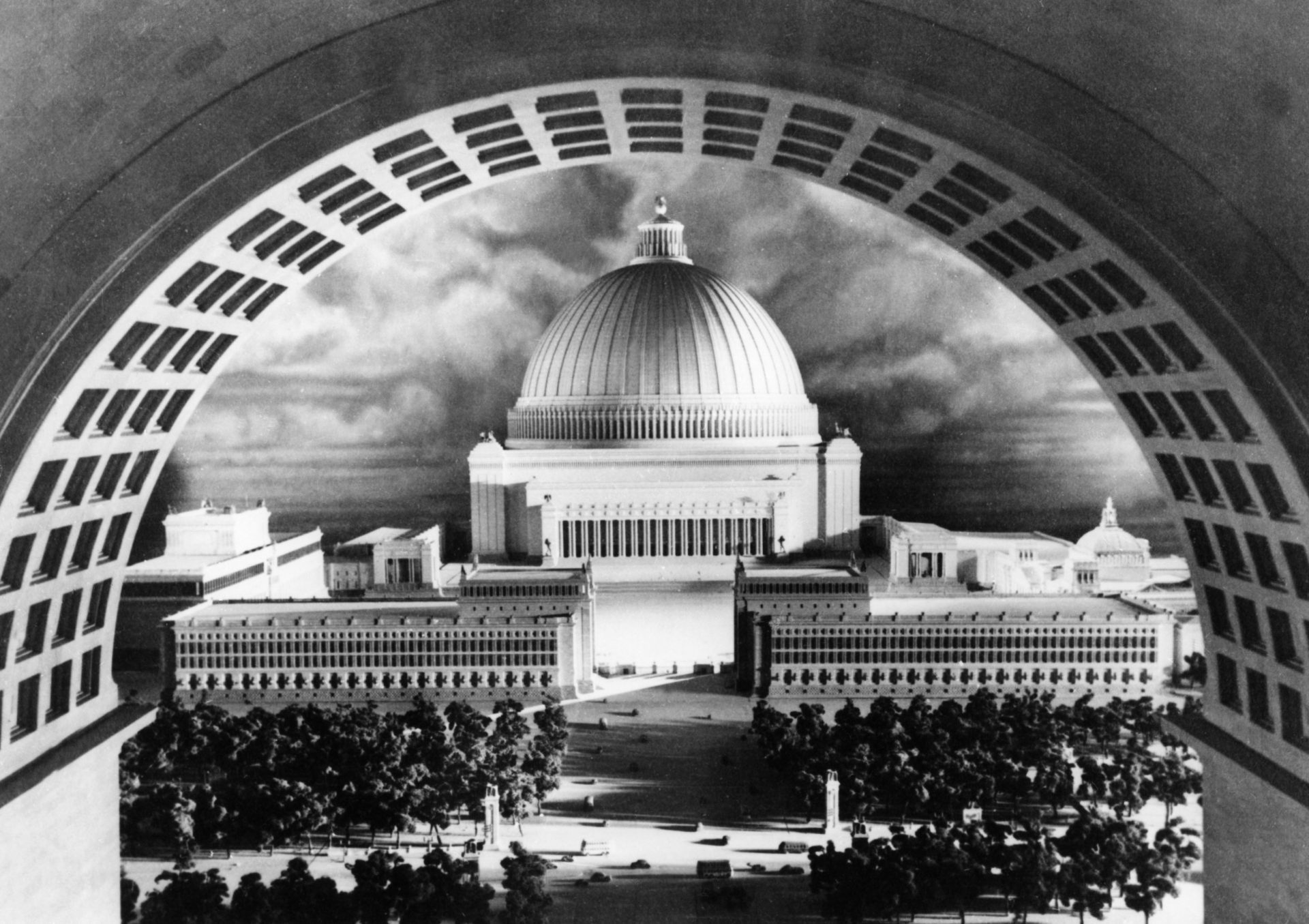Germania was Hitler’s renewal of Berlin, planned to be a megacity at the centre of his Thousand Year Reich, which started construction prior to the outbreak of WWII in 1938 until it was abandoned in 1943.
Hitler envisioned Berlin as a world capital, comparable with the achievements of the Ancient Egyptians, Romans and the Babylonians. Called the ‘Gesamtbauplan für die Reichshauptstadt’, translated as the ‘Comprehensive Construction Plan for the Reich Capital’ was intended to give the greater Germanic world empire of the New Order a capital that would instil a sense of unity amongst those of Germanic descent.
Historians suggest that Hitler first formulated plans for Germania as early as the mid 1920’s, where he drew sketches of elaborate monuments and mentions the rebuilding of German cities in his autobiographical manifesto ‘Mein Kemp’.
Hitler first proposed the concept to architect Albert Speer in the spring of 1936, an ambitious man who had risen in prominence within the Nazi Party through his architectural achievements, resulting in him being appointed to the position of ‘General Building Inspector of the Reich Capital’ (GBI) in 1937 and tasked to bring Hitler’s vision of a new Berlin to life.
Speer had already been commissioned to rebuild the Borsig Palace into offices for the new Sturmabteilung SA leadership, and would later build the enormous New Reich Chancellery which was completed in 1939 and hailed by Hitler as the “crowning glory of the greater German political empire”.
Construction of Germania began in 1938 with the razing of buildings in the Alsen and Tiergarten districts, where many Berliners were evicted from their homes and resettled in properties seized from Jewish families (resulting in many Berlin Jews being resettled in ghettos and ultimately the concentration and extermination camps).
The demand for labour led to many work camps being built near quarries, among them Gross-Rosen, Buchenwald and Mauthausen. German police rounded up what the Nazis considered ‘undesirable’, targeting homosexuals, gypsies and beggars to be worked to death in quarrying stone or baking bricks, with prisoners of war used later in the war as slave labour.
Several previous construction projects were to be incorporated into Germania, including the Tempelhof Airport, the revamped Olympic stadium, the Air Ministry, the Exhibition Hall (part of the International Convention Centre), the extended old Chancellery and the Propaganda Ministry, and the Germans Workers Front Headquarters.

Central Berlin was to be reorganised along a north-south axis boulevard known as the ‘Prachtallee’, meaning ‘Street of Splendours’, running from just west of Tempelhof Airport from the new South Station. This and an east-west boulevard would have divided central Berlin into four quadrants, where the main routes would be closed off for parades and vehicles diverted to use underground highways (parts of which still exist today).
At the northern end of the avenue on the site of the Königsplatz was a planned forum known as ‘Großer Platz’ meaning ‘Grand Plaza’. This was to be the focal centre of Germania, where on the western side was the Führer’s palace, the eastern side the Reichstag Building, and on the southern side the Reich Chancellery and high command of the German Army.
To the north of the Plaza would be the ‘Volkshalle’, meaning ‘Peoples Hall’, an enormous, monumental domed building inspired by Hadrian’s Pantheon in Rome. The temple-like nature of the domed Volkshalle was ultimately intended for public worship of Hitler and Nazi doctrine, with Speer stating in an interview after the war that “Hitler believed that as centuries passed, his huge domed assembly hall would acquire great holy significance and become a hallowed shrine as important to National Socialism as St. Peters in Rome is to Roman Catholicism. Such cultism was at the root of the entire plan.”

Towards the southern end of the avenue would be a triumphal arch based on the Arc de Triomphe in Paris, housing the names of 1,800,000 German soldiers who died during WWI. The arch was meant to erase the shame of the 1919 Treaty of Versailles, instead transforming the 1918 defeat into a victory that would mark the beginning of Germany’s rise to dominate Europe.
Doubts persisted at the time as to whether the marshy Berlin soil could hold the weight of these monumental structures, so Speer ordered the construction of the ‘Schwerbelastungskörper’ in 1941, a large concrete cylinder located at the intersection of Dudenstraße to test the ground in preparation for building the arch.
At the beginning of World War II with the German invasion of Poland in 1939, construction was suspended, but resumed after the clear German victory. The defeat of France in 1940 led to Hitler decreeing: “In the shortest possible time Berlin must be redeveloped and acquire the form that is its due through the greatness of our victory as the capital of a powerful new empire. In the completion of what is now the country’s most important architectural task I see the most significant contribution to our final victory. I expect that it will be completed by the year 1950.”
Hitler’s vision however would never be realised, setbacks during the invasion of the Soviet Union led to further construction of Germania to be permanently halted in 1943, with Berlin falling to the advancing Red Army during the Battle of Berlin in 1945.
Header Image – The Volkshalle, Germania – Image Credit : Prisma by Dukas Presseagentur GmbH – Alamy – IY02357979





